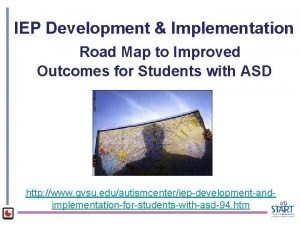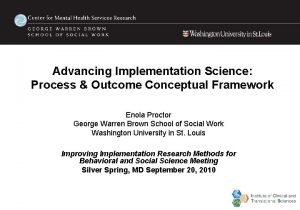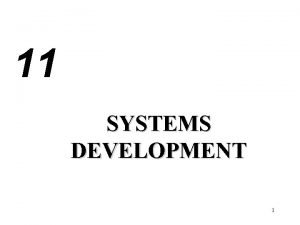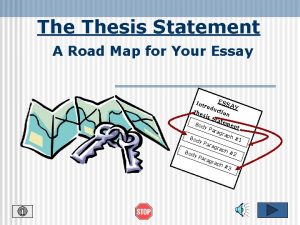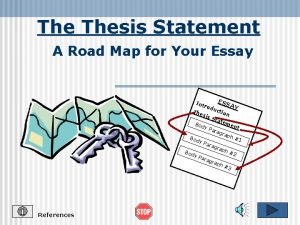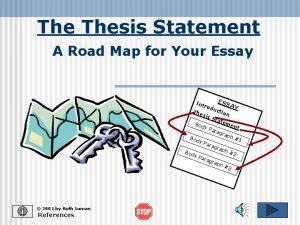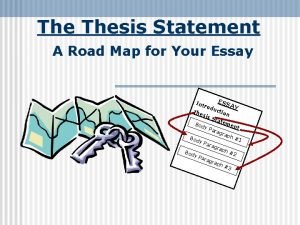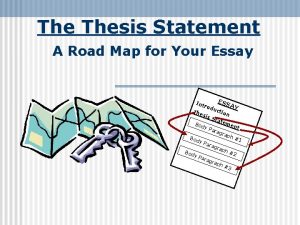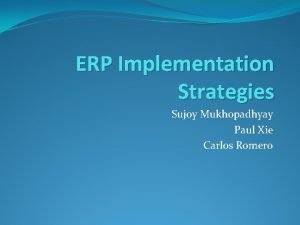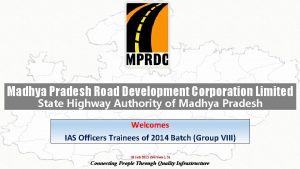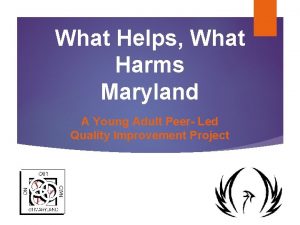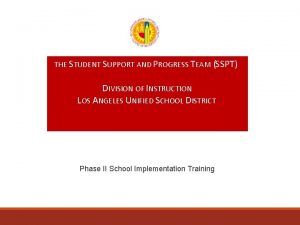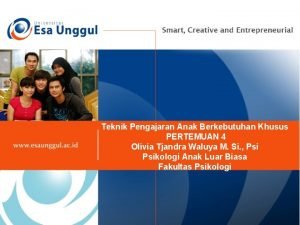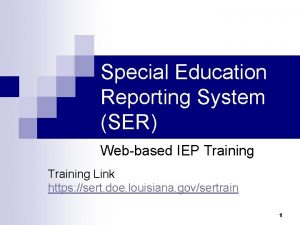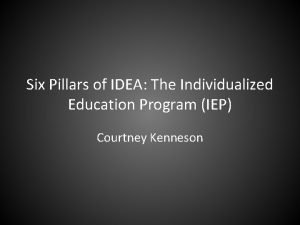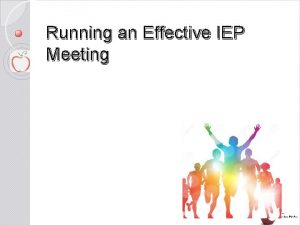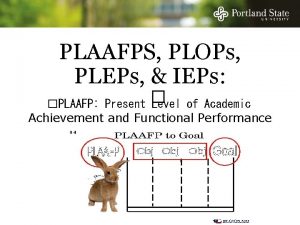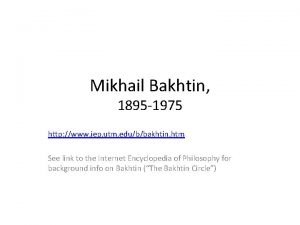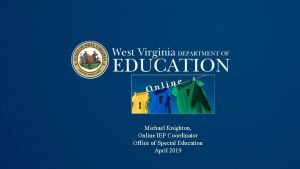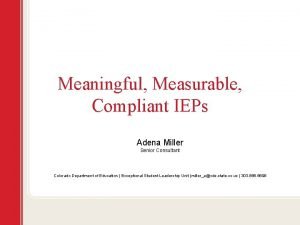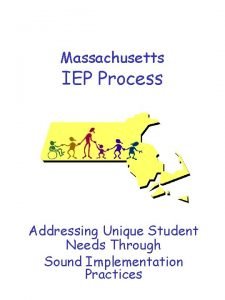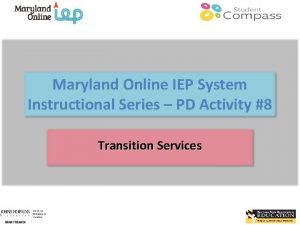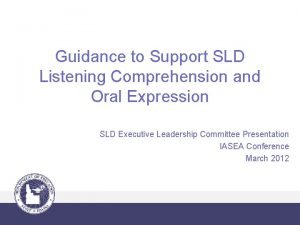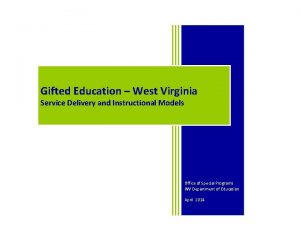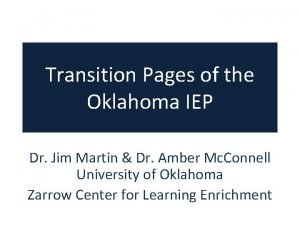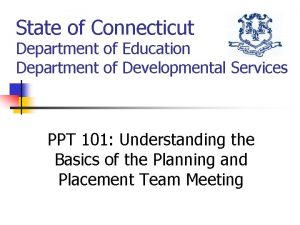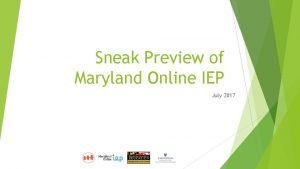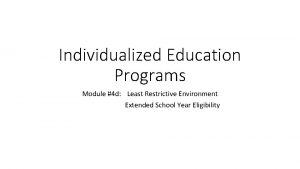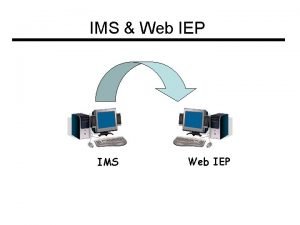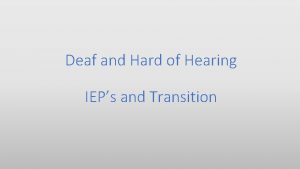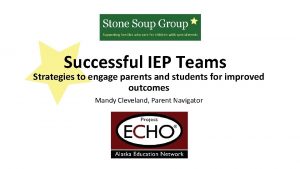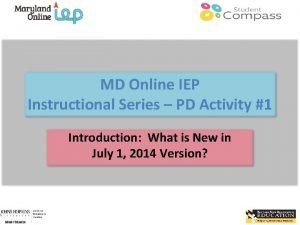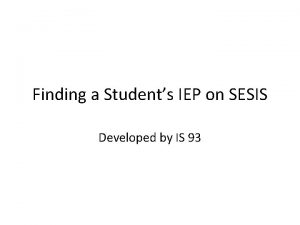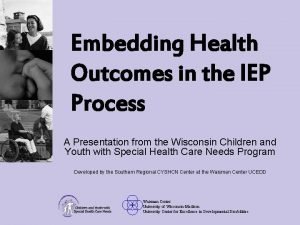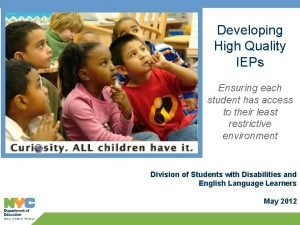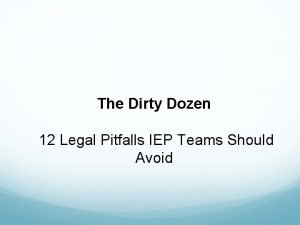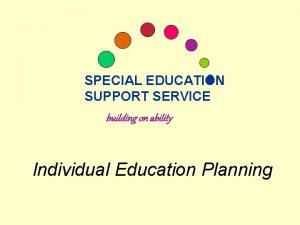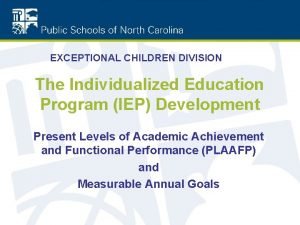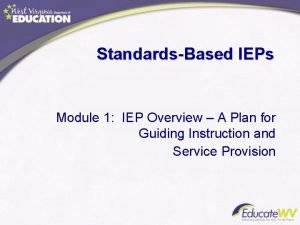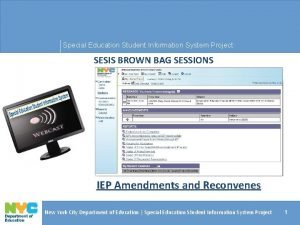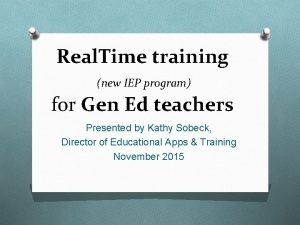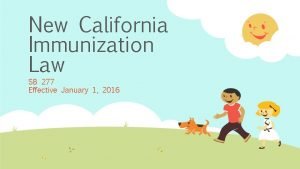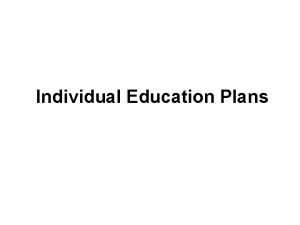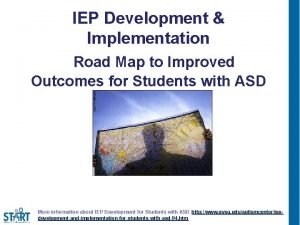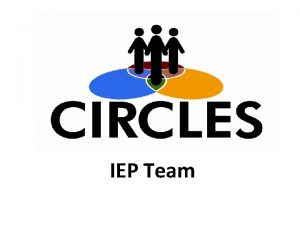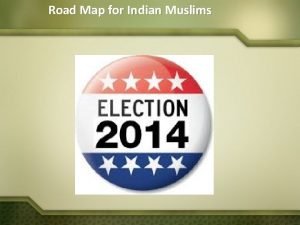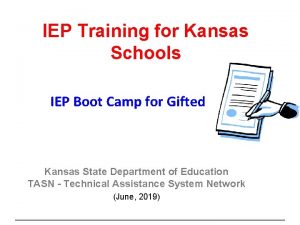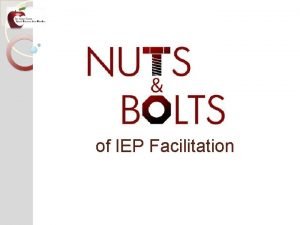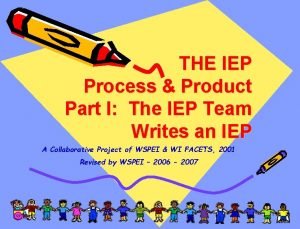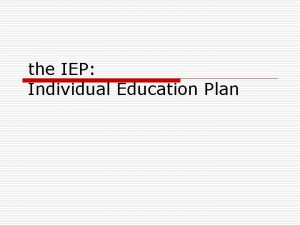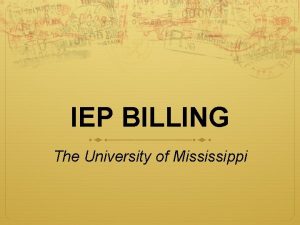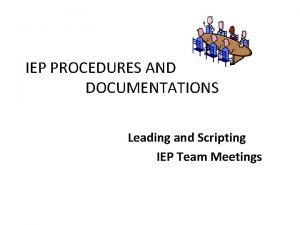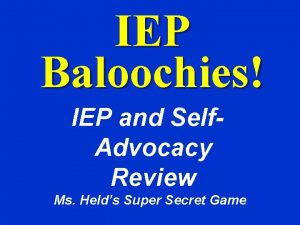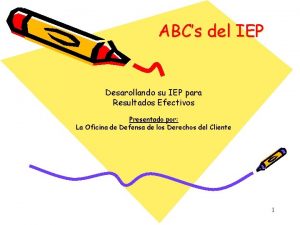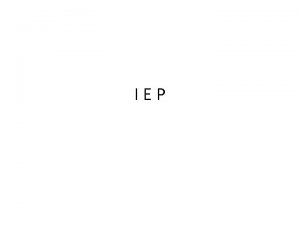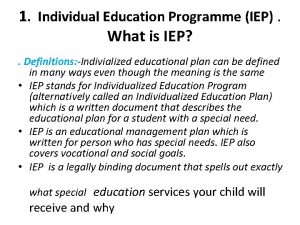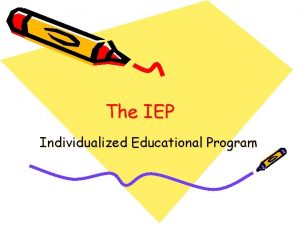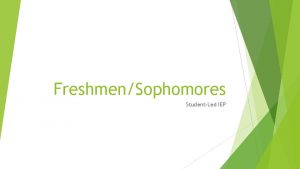IEP Development Implementation Road Map to Improved Outcomes



















































- Slides: 51

IEP Development & Implementation Road Map to Improved Outcomes for Students with ASD http: //www. gvsu. edu/autismcenter/iep-development-andimplementation-for-students-with-asd-94. htm

IEP Module AGENDA • Understanding Special Education – – History of Special Education Vocabulary Lesson Purpose of the IEP Ed Benefit Review • Developing the IEP – – The PLAAFP Supplementary Aids / Services / Personnel Supports Goals and Objectives S. E. Programs/Services and Ancillary/Related Services • IEP Implementation – Implementation Fidelity – Measuring Progress

OUR DECISIONS HAVE TO ALIGN WITH: • THE LAW • THE RESEARCH • THE DATA


Errors in the IEP Process • PLAAFP • Goals and Objectives not related to ASD • Laundry list of SAS • Standard Time for Service • Placement decisions predetermined – Lack of LRE in the Process

the g n i t a g i Nav s Acronym LRE E P FA MET RE ED IDEA BIP FBA ASD

WARNING • I heard that…. • I was told…. PRACTICE IS NOT NECESSARILY LAW, POLICY, or RULE

IDEA Regulations • Two fundamental requirements: – That the child will receive FAPE – In the least restrictive environment (LRE).

What is FAPE? IDEA 2004 An educational program that is individualized to a specific child, designed to meet that child's unique needs, provides access to the general curriculum, meets the grade-level standards established by the state, and from which the child receives educational benefit. (extrapolated from case law and 20 U. S. C. § 1401(14) and 34 CFR 300. 320 through 300. 324 re IEP, and 300. 17 re FAPE definition as special education and related services per IEP) Ed Benefit = progress over time (IEP goals, curriculum, social, communication, behavior, etc. ) To provide FAPE, schools must provide students with an education that prepares the child for further education, employment, and independent living. 20 U. S. C. § 1400(c)(5)(A)(i)

The Test for LRE “To the maximum extent appropriate, children with disabilities…. are educated in the general education classroom with children who are not disabled…” …. and that special classes, separate schooling, or other removal of children with disabilities from regular education environment occurs only if the nature or severity of the disability is such that education in regular classes with the use of supplementary aides and services cannot be achieved satisfactorily. ” 34 C. F. R. § 300. 114

Continuum of Services MI CIMS Thresholds for Restriction SPP Indicator 5: Educational Environments 2016 -17 Targets General Education Classroom 80%+ Target 64% General Education Classroom 40 -79% General Education Classroom <40% Target 11. 5% << Less Restrictive Separate Facility Target 5. 5% More >> https: //osep. grads 360. org/services/PDCService. svc/Get. PDCDocument. File? file. Id=20476


IDEA, 504, and ADA Case Law 9 th Circuit Court of Appeals – Adopted amicus position of US Department of Justice and US Department of Education Office for Civil Rights – IDEA does not limit rights that students with disabilities may have under other laws, including Section 504 and the ADA – Courts are beginning to hear student cases alleging disability discrimination violations under Title II of the ADA

The Dynamic Relationship Between Content, Curriculum and Student Learning: Three Primary Findings • The amount, type, and quality of interactions between students with extensive support needs and their typical peers were better in general education contexts. • Services in general education contexts could be superior to those in self-contained settings with respect to: – The quality of student Individualized Education Programs, the aspects of instruction and the overall program provided – The amount of time that teachers provided instruction – The amount of time students were engaged in instruction and social interactions with general education classmates • When these student received services in inclusive general education contexts, their learning outcomes could be better across skills areas and activities including: – – Social competence Language Development and Use Literacy General education content areas The Dynamic Relationship Between Context, Curriculum, and Student Learning: A Case for Inclusive Education as a Research-based Practice. Jackson, Ryndak, & Wehmeyer, (2010).

Rationale for Segregated Programming Simply Not Supported • Study: 7 years; 6 self-contained; 5 districts; 3 states • Rationale: – Community (i. e. more protective environment) • Not purposefully created or given much attention • Evidence that it, in fact, was the opposite – Less Distractions: SC more frequent; more severe – Curriculum and Instruction: (structure; individualized) • Less structure than gen ed • Context-Free / Meaningless Curriculum (i. e. little inquire-based / cooperative learning; often “seat work; ” no connection to gen ed) • No Specially Trained Instructor – mostly parapros – Behavior Supports: Confrontational staff; Few attempts to understand or respond to function; Contingent removal; Use of time out / restraints Does Self-Contained Special Education Deliver on Its Promises? A Critical Inquiry Into Research and Practice. Causton-Theoharis, Orsati, Cosier, (2011)

LRE=General Education There is STRONG Evidence that Student with “Extensive Support Needs” – Acquire skills and content knowledge (including literacy) in general education with rigorous instruction and UDL-based adaptations (e. g. differentiated instruction; universal supports, literacy supports (Kluth)) – Are BEST served by educational teams that approach their education with the intent of finding solutions to access and learning barriers rather than alternative placements. Involvement and Progress in the General Education Curriculum for Students With Extensive Support Needs: K-12 Inclusive-Education Research and Implications for the Future. Ryndak, Lewis & White, (2013).

Kurth & Mastergeorge, 2010 • • • 15 Ss w/ ASD (not AS) – 12 males 7 -9 th grade; 12 -15 years old 7 >80% day in gen ed 8 self-contained >50% Measures: – Cognitive GE mean 64. 9; SC mean 60. 0 – Adaptive GE mean 44. 4; SC mean 42. 3 – Academic • Reading GE mean 67. 6; SC mean 13. 1 • Writing GE mean 83. 6; SC mean 14. 1 • Math GE mean 77. 4; SC mean 8. 5


Using Meeting Mechanics • • • Visual Support (white / chart board) Facilitator Note-Taker (IEP Form / Computer) Process (Logical IEP Progression) Brainstorming Principles – – Democratic All ideas are considered / recognized Professional Role Elimination OTHERS (FRONTLOAD) • Decision-Making Rules – No opinion unless informed by: • Law; Research; Data

IEP Progress and White Board Template Parent Input PLAAFP Area of Need Data Impact Supplementary Aids / Services Goals & Objectives / Benchmarks Special Education Program and Related Services It is important for family member to offer input without judgement or reaction from staff. When gathering parent input, do not question, disagree, or give explanation to anything they list as issues, concerns, or wishes. Simply write them all on a white board as they are expressed, and then use the list to guide throughout the meeting (whether or not it is a formal IEP) to be sure their input is addressed. To develop a PLAAFP statement, you must identify areas of need related to the student’s ASD and the impact of the ASD on access to and progress in the general education curriculum and environments. The following skill areas should be considered for students with ASD. • Ability to Participate in Instruction (engagement) • Socialization Skills / Competence • Communication • Independent Skills • Transition Issues • Ability to Manage Stress / Anxiety • Behaviors PLAAFP statements must also include assessment and observational data for each area of need compared to peers. Data can be derived from any/all of the following (not an inclusive list) • Standardized measures • Rating Scales • State/Local Assessments • Classroom Output • Grades / Progress Notes • GLCEs --aids, services and other supports that are provided in regular education classes … to enable children with disabilities to be educated with nondisabled children to the maximum extent appropriate. Needs that cannot be met through supplementary aids and services and needs that require specialized instruction must be addressed in goals / objectives and/or benchmarks (or transition plans for transition age students). For every goal, there must be a special education program / service to address it, including, but not limited to: Of the need areas identified in the PLAAFP, which ones can be addressed through the use of supplementary aids and services? Universal supports for students with ASD should always be considered first: • Visual Supports & Strategies • Functional Communication System • Peer to Peer Support • Positive Behavioral Interventions and Supports • Accommodations / Modifications • Appropriate Adult Support Goals & Objectives / Benchmarks must be measurable. Measurable goals & objectives/benchmarks must be designed to meet the needs of the student that result from the disability to enable the child to be involved and make progress in the general education curriculum. Goals & objectives / should NOT be a restatement of the general education curriculum or a list of everything the student is expected to learn. They should be the prioritized needs from the PLAAFT. It’s often helpful to ask, “What skills does the student need in order to access / master the content? ” rather than “What content the student needs to learn? ” Services: SLP, SSW, OT/PT: Determine amount of time needed to assis the student in making adequate progress on goals / objectives. Consider push -in services FIRST. Placement / Program: The question to ask to ensure LRE is considered in the planning for placement is: “With the identified supplementary aids / services and push in itinerant / related services, can the student make adequate progress on the goals and objectives? ” If yes, no placement outside of the general education is needed. If not, what amount of time would the student need to be pulled from the general education environment to work specifically on the goal(s) to ensure adequate progress? What placement is most conducive to working on the goals / objectives?

Data to Support Impact and Need ENGAGEMENT, INDEPENDENCE, SOCIAL http: //www. gvsu. edu/autismcenter/individual-studentdata-collection-forms-217. htm

Elicit Parent Input AVOID Guiding Principles Enhance

PLAAFP Statement Framework AREAS of the student’s DISABILITY that impact access to and participation & progress in: The general education CURRICULUM General education ENVIRONMENTS (including social skill development, independent skills, etc. )? • Ability to Participate in Instruction • Socialization Skills / Competence • Communication • Independent Skills • Transition Issues • Ability to Manage Stress / Anxiety • Behaviors How do these needs IMPACT Data for access to, EACH area— involvement & participation in, COMPARED success in general TO PEERS education CURRICULUM and ENVIRONMENTS?

What about “ACADEMIC ACHIEVEMENT? ” • ED did not define “academic achievement” • 2006 IDEA Regulations: – “’Academic achievement’ generally refers to a child’s performance in academic areas (e. g. reading, math, science. . ). We believe the definition could vary depending on a child’s circumstance or situation, and therefore, we do not believe a definition of ‘academic achievement’ should be included in these regulations. ” • ASD Eligibility Requirements….

OPTIONS for DATA • • • Standardized Measures Rating Scales State / Local Assessments Behavior Plans / Logs Classroom Output Grades / Progress on Current IEP Goals Direct Observation GLCEs MDE Quick Reference Guide: Section 2 PLAAFP


• Just because there is a NEED does not mean you need a GOAL— • However, you MUST address each need identified in the PLAAFP in another appropriate section of the IEP…. – Secondary Transition Considerations – Supplementary Aids and Services – Goals and Objectives / Benchmarks

What ARE Supplementary Aids / Services? • § 300. 42 Supplementary aids and services means aids, services, and other supports that are provided in regular education classes, other education-related settings, and in extracurricular and nonacademic settings, to enable children with disabilities to be educated with nondisabled children to the maximum extent appropriate in accordance with §§ 300. 114 through 300. 116. (Authority: 20 U. S. C. 1401(33))

MDE Interpretation of the Purpose of Supplementary Aids and Services • Provided to enable the student to: – Advance appropriately toward attaining the annual IEP goals. – Be involved and progress in the general education curriculum and to participate in extra-curricular and other nonacademic activities. – Be educated and participate in activities with other students with disabilities and nondisabled students. MDE OSE-EIS Quick Reference Guide: Section 5

Supplementary Aids / Services Universal Supports (the Non-Negotiables) • Visual / Organizational Supports • Functional Communication System • Accommodations / Differentation • Peer to Peer Support • Positive Behavioral Interventions and Supports • Appropriate Adult Support (INDEPENDENCE FACILITATORS)

Translating PROCESS to PAPER Documenting Intensive Individualized Plans • VARIABLES: – Nature of the support varies significantly (day to day, content to content, etc. ) – Support is intensive in nature – Support includes a lot of details

Targeting Goal AREAS 1. Needs that CANNOT be met through supplementary aids and services (or secondary transition)… AND / OR 2. Needs and/or Supports from Supplementary Aids and Services that require “specialized instruction”

Writing Goals (Objectives / Benchmarks) UTILIZING…. Student Will…. Under what conditions? At what level / degree (criteria)? The IEP Form: ADD: by what date; on what assessment? Does not have line for: Utilizing

Writing Measurable Goals Formula for Success • UTILIZING—Using WHAT tool, support, system, etc. will the student learn to perform the skill? • • • Utilizing a visual schedule Using peers / peer to peer support Using a picture choice board When provided a visual prompt Using a visual functional communication system Utilizing a routine checklist When given a check schedule card Using a choice differentiation Using a self-management checklist

Resources for EBPs • NPDC (http: //autismpdc. fpg. unc. edu/) • National Standards Project (http: //www. nationalautismcenter. org/nationalstandards-project/phase-2/) • AIM (Autism Internet Modules) by OCALI (http: //www. autisminternetmodules. org) • AFIRM (NPDC) http: //afirm. fpg. unc. edu/afirm-modules • Association for Science in Autism Treatment (http: //www. asatonline. org/treatments_desc. htm )

Writing Measurable Goals Formula for Success UTILIZING—Using WHAT tool, support, system, etc. will the student learn to perform the skill? Behavior—Get some VERBS in your sentence What competency / skill should change? OBSERVABLE Conditions / Criteria— Under what conditions and how MUCH / WELL will be considered mastery for the time frame of the IEP (use peers)?

CRITERIA / Mastery • • • 9 out of 10 trials / opportunities 6 items / assignments 75% accuracy Increase by 10% 3 times a day On 9 consecutive attempts For 15 minutes at a time Within 5 minutes 4 times weekly 3 out of 5 days 4 class periods


GOALS & OBJECTIVES / BENCHMARKS Guided Practice Chris will raise his hand when he needs assistance or wants to share important information. (90% of time)

GOALS & OBJECTIVES / BENCHMARKS Guided Practice • Utilizing a self-management checklist (STRATEGY) Chris will raise his hand share a key idea (BEHAVIOR) during science and social studies (CONDITION) 4 of 5 opportunities (CRITERIA). Section 4: Option 1 Goals and Objectives / Benchmarks Instructional Area – list the appropriate content area (e. g. , strand / domain): Michigan Content Expectations Upon Which Goal Will Be Based – List the appropriate GLCE, EGLCE, HSCE, EHSCE, or Early Childhood Standards of Quality for Pre-kindergarten: Baseline Data: The student is currently ____(data)______ on the ________(assessment)_______________. Annual Goal By __(date)__, the student will ___(demonstrate skill)___when/at__(conditions criteria)__on _(assessment/evaluation )__. Short-Term Objective / Benchmark: __________________________________ Performance Criteria: ________________________________________ Evaluation Procedure: ________________________________________ Evaluation Schedule: ________________________________________

Benchmark Level of Attainment Goal Area : Engagement 0 Chris does not participate in discussions in his science and social studies classes despite having a lot of knowledge about the topics. He does ask questions, but only about the specifics of assignments (e. g. when they are due, how many references he needs, etc. ). +1 Utilizing a self-management checklist and no more than 3 visual prompts, Chris will raise his hand share a key idea during science 2 of 5 opportunities. +2 Utilizing a self-management checklist, Chris will independently raise his hand share a key idea during science 2 of 5 opportunities. +3 +4 Utilizing a self-management checklist, Chris will independently raise his hand share a key idea during science and social studies 2 of 5 opportunities. . Utilizing a self-management checklist, Chris will raise his hand share a key idea during science and social studies 4 of 5 opportunities.



The LRE Question With supplementary aids / services AND / OR Push in ancillary / itinerant / related services can the student make adequate progress on the IEP goals and objectives? • If yes, no pull out program / services is needed…. NO RESTRICTION – GEN ED PLACEMENT…. • If no, what level of restriction is needed and for what program / related services in order to assure adequate progress on the IEP goals and objective / benchmarks AND more than minimal progress in the general education curriculum.



Implementing the IEP • Fidelity Tools • Measuring / Probing Progress

IEP Implementation Fidelity Plan Student Name: __________ District / Building: _______________ IEP Date: ________ This tool is intended to assist IEP teams in implementing identified universal supports and the IEP with fidelity. It can be used as a guide for staff to know where and when the IEP goals and supplementary aids and services are to be implemented and can be used as an observation tool for conducting implementation fidelity checks. If a Schedule Matrix was completed as a part of the IEP process, it can be used as the foundation for the IEP implementation plan by simply adding the IEP information columns to the already completed Schedule Matrix. Considerations for strong implementation also include developing staff competencies in EPB, providing ongoing training and coaching needed for implementation staff, identifying needed resources, and developing communication feedback systems for the team. Additionally, specific fidelity checklists for each identified intervention can be developed and used to ensure each intervention or strategy is implemented as it was designed. This tool is intended to be reviewed monthly. Student Schedule Expectations & Instructional Outcomes IEP Goals / Objectives Targeted / Addressed Supports, Strategies, EBPs & Services Implementation Fidelity and Progress Data In this column, list the student’s daily schedule including all primary activities, courses/classe s and/or transitions In this column, identify the student’s expectations & instructional outcomes during this part of the schedule. Expectations and instructional outcomes include: • Independence Skills • Social Interaction Skills • Communication Skills • Behavioral Skills • Academic Skills including task initiation, engagement, & output For example, during “arrival, ” the instructional outcomes may include independently taking off outerwear, getting materials ready, taking a seat, and completing morning work. Identify in this column where the IEP goals and/or objectives and benchmarks from the IEP are addressed or targeted within the student’s schedule. List in the column, all the supplementary aides and services (including universal supports) required to support the student in making progress on goals and objectives, meeting instructional outcomes, and navigating the environment and participating in instruction as independently as possible. These include but are not limited to: • Visual supports / strategies • Peer to Peer supports • Functional Communication Systems • Positive Behavioral Interventions & Supports • Evidence-Based Practices • Accommodations / Modifications • Behavior Response / Crisis Plan • Adult Support (include ONLY if previous supports require teaching or additional adult intervention)-If adult support is required, attach the “Paraprofessional Planning Tool” It is critical for IEP teams to do regular checks for evidence of implementation of the IEP and progress toward goals. This column is reserved for implementation fidelity and progress data and should be tailored to the type of data needed to demonstrate progress toward IEP goals and objectives or benchmarks and data needed to demonstrate implementation fidelity. Progress data may include: • Frequency / Duration • Interval / Scatterplot Records • Academic (e. g. CBM) • START Engagement, Independence, and Social Interaction Tools • Behavior Logs • Prompt-Level Data Implementation Fidelity Plans and Data may include: • Fidelity Checklists • Staff Training and Coaching • Implementation process questions (e. g. is strategy implemented where/when expected? Is staff implementing as described? Is student using the system independently? Is the student making progress using the system? ) Each IEP goal and objective or benchmark may be listed more than once in this column as most goals and objectives or benchmarks can be targeted during more than one part of the schedule.



SUMMARY and IMPLEMENTATION QUESTIONS / CLARIFICATIONS SELECT at least ONE CONCEPT to IMPLEMENT
 Iep development and implementation
Iep development and implementation Proctor implementation outcomes
Proctor implementation outcomes Roles of iep team members
Roles of iep team members A road map indicating the direction of systems development
A road map indicating the direction of systems development Thesis paragraph
Thesis paragraph Thesis statement road map
Thesis statement road map Thesis statement
Thesis statement Thesis development and road map
Thesis development and road map Road map thesis
Road map thesis Vanilla approach erp
Vanilla approach erp Paved road vs unpaved road
Paved road vs unpaved road 8 phases of sdlc
8 phases of sdlc Madhya pradesh road development corporation
Madhya pradesh road development corporation Iep meeting quotes
Iep meeting quotes Sspt forms lausd
Sspt forms lausd Contoh iep
Contoh iep Https//serp.doe.louisiana.gov/ser
Https//serp.doe.louisiana.gov/ser Pillars of idea
Pillars of idea Iep meeting agenda
Iep meeting agenda Plaafp examples
Plaafp examples Iep utm edu
Iep utm edu Md online iep
Md online iep Examples of iep goals and objectives
Examples of iep goals and objectives Iep justification statement examples
Iep justification statement examples Iep md online
Iep md online Iep meeting agenda
Iep meeting agenda Sld oral expression
Sld oral expression Characteristics of gifted students
Characteristics of gifted students Iep goal for citing textual evidence
Iep goal for citing textual evidence Oklahoma iep
Oklahoma iep Student led iep script
Student led iep script Iep components special education
Iep components special education Moiep md
Moiep md Esy justification statement
Esy justification statement Webiep
Webiep Iep virgen maria
Iep virgen maria Wvde iep
Wvde iep Gifted iep goals
Gifted iep goals Iep
Iep Md online iep
Md online iep Sesis login
Sesis login Iep
Iep Quality services iep
Quality services iep Iep trailer chassis only
Iep trailer chassis only Iep meeting do's and don'ts
Iep meeting do's and don'ts Iep process
Iep process Present levels of performance iep examples
Present levels of performance iep examples Iep
Iep Rexiona
Rexiona Realtime iep
Realtime iep Sb277 iep exemption
Sb277 iep exemption Individualized education plan
Individualized education plan
